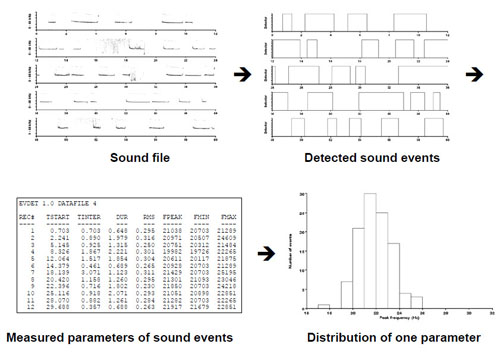Products
Home | Company | Products | Sales | Support | What's New | SIGNAL in Science | Contact | Search
Click here to download PDF brochures
|
Engineering Design offers a range of software for bioacoustic analysis and experimentation. |
SIGNALtm is the recognized standard in bioacoustic analysis for accuracy, flexibility, mathematical power and automation. SIGNAL 5 provides a graphical environment for viewing, measuring, and manipulating signals combined with an extensive mathematical toolbox and advanced programming capabilities. Extensive menus, help system, a 30-chapter interactive TUTOR and a 1000-page manual help users browse the extensive capabilities of the system and learn them in depth. Features include sound editing, manipulation and synthesis; multi-window graph displays with on-screen measurement; a spreadsheet-style log file for screen measurements; a macro recorder for easy programming; built-in graph screen capture; and export of sound, image, and measurement files. Built-in analog I/O provides timed, scheduled and continuous recording and programmable playback for stimulus selection, repetition, variation, timing and scheduling. These capabilities are further extended by Experiment Makertm. SIGNAL 4 users can review what's new in SIGNAL 5 brochures and take a slide show tour. |
| SIGNAL runs on Macintosh computers. |
|
Real-Time Spectrogram (RTS) tm provides viewing, measurement, and editing of unlimited-length sound files. The time-aligned spectrogram and waveform can be scrolled forward or backward and zoomed to any resolution. Segments can be rapidly drag-highlighted and and stored to disk. Built-in sound acquisition and playback will be added to the RTS in the future.RTS is highly integrated with SIGNAL. You can transfer sound events to SIGNAL buffers for analysis and store measured sound parameters in the SIGNAL logfile. You can save sound segments as SIGNAL, Wave or AIFF sound files. You can display SIGNAL buffers in any number of scrolling RTS windows for visual comparison. |
| The Event Detectortm can automatically extract the sound events from an unlimited length sound file, extracting individual sound events according to user specifications, measuring sound parameters and storing the measurements in a spreadsheet-compatible log file. Detected sound events can be further analyzed in SIGNAL to measure, count, compare, classify, time-stamp, and store sound events and sound parameters. |
| The Event Analyzertm represents a breakthrough in the analysis of repetitive acoustic events as diverse as field recordings of birdsong or laboratory ultrasonic rodent vocalizations. It can go automatically from raw acoustic data to summary behavioral acoustic measurements and statistics, such as call rate, call duration, peak frequency, etc. The Event Analyzer automates and integrates event detection, event measurement, and statistical analysis and display, reducing these processes to a collection of menus, configuration settings, automatic and interactive measurements, diagnostic tools, statistical analyses, and histogram displays, and saving the user potentially months of custom programming. |  |
| Experiment Makertm turns SIGNAL into a programmable, automated, real-time experiment control system by adding capabilities for simultaneous acquisition and playback, microsecond timing and triggering, digital I/O and keyboard control. Experiment Maker allows the researcher to construct presentation, measurement and control systems that would otherwise require months of programming.
Applications include dynamic stimulus selection, timed playbacks, adaptive playbacks, reaction time and integrated acoustic and visual testing. Playback stimuli can be constructed and selected in real-time, based on any combination of stored stimuli, random selection, user input, subject responses and experimental conditions and triggers. Stimulus choice, subject response, and experimental conditions can be logged for later analysis. |